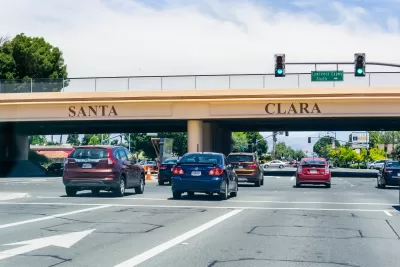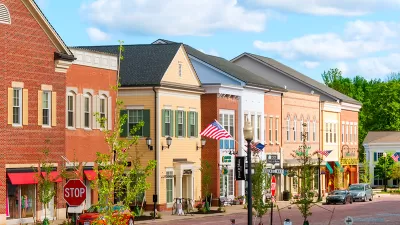The built environment in one of the most affluent places in the country leaves much to be desired. Why are Silicon Valley communities missing so many key urban features?

Picture Silicon Valley and you might imagine “techies doing cool tech things on every sidewalk, in every restaurant and juice bar, in every garage and loft, on every bus, train, scooter, and hoverboard.” But that’s far from the reality, writes Josh Stephens in Common Edge.
The real Silicon Valley is so dull, it makes you want to climb atop the nearest standing desk and hurl yourself off headfirst. It makes you want to put on VR goggles and never take them off.
For Stephens, Santa Clara, arguably the center of Silicon Valley, is “somehow, even more bleak” than its endless office parks, strip malls, and mid-density apartment complexes would imply. With an average home price of $1.5 million and rents at over $3,000 per month, Santa Clara is an unusual yet “ordinary example of 20th century urbanism.” A bigger question might be, “is Santa Clara’s bleakness a feature or a bug? Why do all of those wealthy people and wealthy companies want to live with all of that ugliness?”
The wealth in Santa Clara, unlike more ostentatious enclaves like, say, Beverly Hills, is hidden, Stephens writes, in part because if it was more apparent, maybe people would demand a more livable, affordable community. “Meanwhile, all over the Bay Area, young professionals sleep on sofas; public-sector workers commute in from beyond the horizon; people reside in boxes up in the Tenderloin; and low-income workers without cars live extralegally wherever they can.”
Stephens asserts that Santa Clara “warrants scrutiny for all that it has squandered,” using none of its immense wealth to create anything close to a vibrant city. “If the city harnessed even a fraction of the capital sloshing around its city limits, it could transform itself into a model of equity, sustainability, and creativity.”
Stephens concludes that “Santa Clara’s underperformance is not a moral failing exactly. Cities rise and fall collectively.” Santa Clara may offer a high-profile example of our failures, but it’s nevertheless part of a collective failure.
FULL STORY: Is Santa Clara—the Heart of Silicon Valley—Soulless and Banal by Intent?

Planetizen Federal Action Tracker
A weekly monitor of how Trump’s orders and actions are impacting planners and planning in America.

Chicago’s Ghost Rails
Just beneath the surface of the modern city lie the remnants of its expansive early 20th-century streetcar system.

San Antonio and Austin are Fusing Into one Massive Megaregion
The region spanning the two central Texas cities is growing fast, posing challenges for local infrastructure and water supplies.

Since Zion's Shuttles Went Electric “The Smog is Gone”
Visitors to Zion National Park can enjoy the canyon via the nation’s first fully electric park shuttle system.

Trump Distributing DOT Safety Funds at 1/10 Rate of Biden
Funds for Safe Streets and other transportation safety and equity programs are being held up by administrative reviews and conflicts with the Trump administration’s priorities.

German Cities Subsidize Taxis for Women Amid Wave of Violence
Free or low-cost taxi rides can help women navigate cities more safely, but critics say the programs don't address the root causes of violence against women.
Urban Design for Planners 1: Software Tools
This six-course series explores essential urban design concepts using open source software and equips planners with the tools they need to participate fully in the urban design process.
Planning for Universal Design
Learn the tools for implementing Universal Design in planning regulations.
planning NEXT
Appalachian Highlands Housing Partners
Mpact (founded as Rail~Volution)
City of Camden Redevelopment Agency
City of Astoria
City of Portland
City of Laramie





























